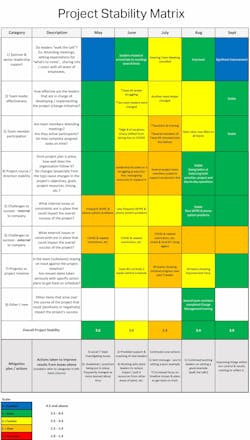Keeping a Project Stable in Uncharted Waters
Successfully running a project in 2020 has all of the typical challenges, along with many new difficulties related to COVID-19. In these uncertain times, how do we keep things moving ahead even when we are navigating through choppy waters?
This was a challenge I faced early this year as I led a reliability transformation at a large U.S. manufacturing plant. The project kicked off in early spring, just as we were learning more about COVID-19 on a daily, even hourly, basis. The leadership team deliberated whether they should delay this project. They decided to move forward with the initiative because it was a key component of the company’s strategic improvement plan.
Smooth sailing, despite a storm on the horizon?
We put the foundational project elements into place:
- Established strong, cross-functional project teams
- Created a steering team, as well as a separate OCM (organizational change management) team
- Developed a detailed project plan that included tasks, start/finish dates, and names
- Pulled together materials needed for kick-off meetings and overview training sessions
Early on, the team spent considerable time and effort creating processes for continued safe operations during a growing health crisis, by then determined to be a true pandemic. For example, face-to-face meetings were limited to small groups of five or less, so most team sessions had to be conducted via Skype. Due to system and hardware limitations at the plant, this became an immediate problem. However, the IT team provided the effort and creativity to mitigate the issues so they weren’t “show stoppers.” Despite COVID-related challenges, the project was launched with strong leadership support and got off to a surprisingly good start.
The storm before the calm
At the plant, every day presented new challenges. Production volumes (demand) swung wildly as customers tried to determine their requirements in a COVID world. Activities done one day based on the latest learnings might be reversed the next due to newer information. Increasing levels of frustration became evident at all levels of the organization.
By June, several new challenges appeared:
- Team sponsors had begun missing project meetings or regularly arriving late.
- Two of the three work stream team leaders had to be replaced (one due to performance issues; one left the company).
- Team members were missing meetings (many employees were taking vacations that had initially been planned for spring).
- Beyond the project, plant leaders recognized that ongoing issues with a key production line were getting worse.
Individually, none of these issues would be crippling, but taken together they made it difficult to keep the project on course. The production line issue led to multiple activities intended to improve the line’s poor performance. This included shuffling resources to provide additional technical horsepower to the area. As a result, several members were removed from improvement project teams at a critical time (mid-process design). In retrospect, these changes were not communicated well to the broader organization, or even to the project teams, at that time. At this stage, frustration, and now fatigue, was becoming part of day-to-day life at the plant.
For the most part, reviewing project metrics and tracking tasks via the project plan did not paint the picture of a project in trouble. However, it was easy to see during team meetings that much of the initial enthusiasm was now gone and that frustration was increasing at all levels of the organization. What was needed was a simple, visual tool that would provide a view of our project’s stability. At this stage, it didn’t feel like we were very stable, but I didn’t have anything to demonstrate that feeling.
After some head scratching and several iterations, I developed the stability matrix shown below. I selected categories that fit this specific project. However, it would be easy to modify the list of categories to fit almost any project, particularly those within the realm of change management. The tool is simple to use as explained in the box below the matrix (“Calculating Overall Project Stability”).
(Article continues beneath image. To see the image in a larger format, click here. It will open in a new window.)
With a navigation chart in hand, there’s smoother water ahead
The project’s sponsor believed that this would be a great tool to share with plant leadership during steering team meetings. Each month, prior to the meeting, we discuss the status of each line (category) and agree on the color that we believe is most accurate. We also include snippets of information, especially when the color selected represents a decline. In the bottom row, we capture the actions necessary to drive improvement.
Reviewing this tool during steering team meetings has helped keep the project moving forward. The attendees control all of the resources within the plant and specifically those needed for this type of project to succeed. An even bigger benefit has been that the leadership team sees firsthand how impactful their actions (or inactions) can be. For example:
- It quickly became clear that there was a noticeable reduction in the level of enthusiasm at team meetings once leaders began missing them or arriving late.
- With so much focus on the struggling production line, it later became clear that folks working on this initiative believed that the project was no longer important. This was reinforced once several team members were removed from the project and reassigned to support the production line.
Even though there were multiple, critical activities that needed to be juggled, including meeting production (customer) demand, it was never leadership’s intention to place this project on the back burner. Once these issues were highlighted, the steering team was quick to take the actions necessary to get the project headed back in the right direction.
Here are a few takeaways and lessons learned from this project:
- Many of the biggest challenges to the project’s success were only indirectly related to COVID-19. However, employee frustration and fatigue associated with working in a manufacturing environment rife with uncertainty definitely played a major role.
- This tool provides a good, high-level visual indication of project stability. However, this is only a small part of the metrics that need to be established for a project. Ideally, the stability matrix should be included within an executive dashboard created at the beginning of an initiative.
So, would we have been successful without the using the Project Stability matrix? Possibly. However, this tool helped the leadership team observe, almost in "real time," the impact of their decisions and activities. Real time is a relative phrase, and here it means that employee attitudes could be gauged on a month-by-month basis, rather than on a yearly or multiyear basis, which is more typical for organizational behavior measures. In this situation, the Project Stability matrix helped turn around an important project that was quickly heading into rough water.
Bruce Warthen is a principal consultant with Life Cycle Engineering. His career includes 30-plus years of experience in creating and leading successful reliability-focused organizations. You can reach Bruce at [email protected].


